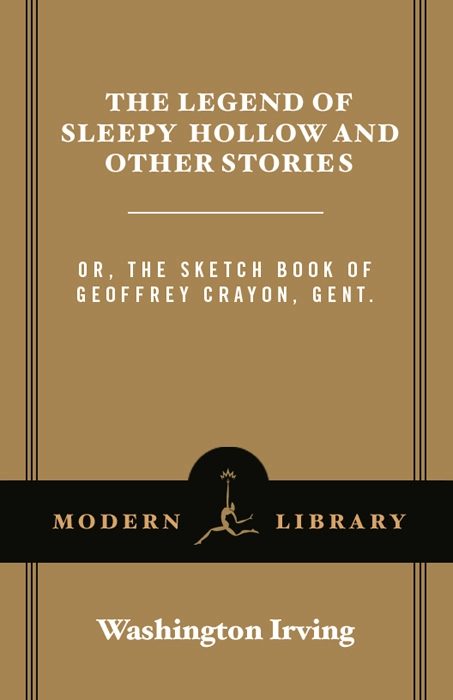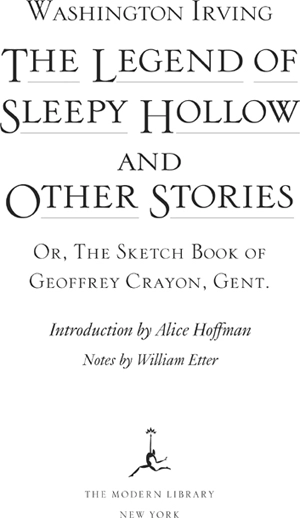The Legend of Sleepy Hollow and Other Stories


WASHINGTON IRVING
Washington Irving, America’s first internationally acclaimed man of letters and the father of the American short story, was born in New York City on April 3, 1783. He was the eleventh and youngest child of a prosperous merchant who had emigrated to the United States from Scotland. Though he grew up in a strict Presbyterian household that valued the Puritan ethic of hard work, Irving experienced a pampered childhood and received but a fragmentary education. As a teenager he delighted in exploring the lower Hudson Valley, an area that would later figure prominently in his writing. Instead of following his older brothers to Columbia College, Irving read books on history and travel, and was especially drawn to the social satire of Cervantes, Fielding, and Rabelais. In 1802, while clerking in a Manhattan law office, he wrote a series of comic reports on theater, fashion, and society that appeared in the New York Morning Chronicle under the signature of “Jonathan Oldstyle, Gent,” the first of many pseudonyms. Upon returning from a two-year tour of Europe, he collaborated on Salmagundi; or, the Whim-Whams and Opinions of Launcelot Langstaff, Esq., and Others (1807-1808), a gossipy, irreverent potpourri which displayed a roguish style of satire and burlesque that invited comparison with the essays Addison and Steele had written for the Tatler and the Spectator.
Irving’s reputation as a writer was greatly enhanced by A History of New York (1809), his first full-length book. Posing as Diedrich Knickerbocker, an absentminded professor of Dutch-American history, he offered up a boisterous spoof that lampooned the Dutch colonization of New York. After a brief period as editor of the Analectic Magazine, he moved to England in 1815 to work in a branch of his family’s import-export business. When the company declared bankruptcy three years later, Irving turned full-time to writing. The serial publication of The Sketch Book of Geoffrey Crayon, Gent. in 1819 and 1820 made him a literary celebrity on both sides of the Atlantic. He was lionized by English society and hailed by William Thackeray as “the first ambassador whom the New World of letters sent to the Old” Generally considered the finest example of Irving’s artistry, the collection of lightly humorous sketches, tales, and travel reminiscences contains his two best-known short stories, “Rip Van Winkle” and “The Legend of Sleepy Hollow” He subsequently capitalized on the popularity of The Sketch Book with several Geoffrey Crayon sequels, most of them evocative of European scenes and the European past, including Bracebridge Hall (1822), Tales of a Traveller (1824), The Alhambra (1832), and The Crayon Miscellany (1835). Irving’s career took a new direction with his appointment in 1826 as attaché to the American legation in Madrid. Turning his attention to nonfiction he soon completed A History of the Life and Voyages of Christopher Columbus (1828) and went on to write several other works based on Spanish themes, namely A Chronicle of the Conquest of Granada (1829), Voyages and Discoveries of the Companions of Columbus (1831), and Legends of the Conquest of Spain (1835).
Irving returned to the United States in 1832 after an absence of seventeen years. A journey to the West exposed him to life on the frontier and inspired A Tour on the Prairies (1835) as well as two accounts of the western fur trade, Astoria (1836) and Adventures of Captain Bonneville(1837). From 1842 to 1846 he served as minister to Spain at the court of Isabella II. Afterwards he retired to Sunnyside, his home on the banks of the Hudson River near Tarrytown, New York. During the final decade of his life he turned out Oliver Goldsmith (1849), a biography of the English novelist and playwright; Mahomet and His Successors(1850), a chronicle of the Moslem empire; Wolfert’s Roost (1855), a collection of sketches and stories originally published in the Knickerbocker Magazine; and The Life of George Washington (1855-1859), a five-volume popular biography of his presidential namesake. Washington Irving died at Sunnyside on November 28, 1859, and was buried three days later at Sleepy Hollow Cemetery in Tarrytown.
In considering the enduring appeal of Irving’s most popular stories, Clifton Fadiman observed: “We find it hard to think of ‘Rip Van Winkle’ as a tale actually written by a real man named Washington Irving. We think of it instead as a folk tale that we seem to have known all our lives…. Irving made a work of art out of a simple and rather dull legend. Into it he put his feeling for an older, quieter, more innocent America which, even in his time, he knew would never come again. Into it he put his love for the mysterious mountains near his home, for the lordly Hudson that for many of us has some of the magic of the Mississippi. I think it’s the feeling for the past that makes this simple story cast such a spell. It seems to be about the childhood of our country, which we can never relive, except in fancy….’ The Legend of Sleepy Hollow’ has some of the same charm, but more humor and action, together with the attraction of a good ghost story…. [Both] should be read as Irving wrote them—in a relaxed, almost dreamy mood. They come out of the mists of far away and long ago, out of an era in our history when time seemed to stand still, when America drowsed peacefully, unaware of its great and stirring future” Richard Ellmann stated: “The first American short story, [‘Rip Van Winkle’] has become standard reading outside as well as inside the English-speaking world…. The subterranean power of this work made Rip Van Winkle… one of the great figures of the nineteenth-century imagination.”
CONTENTS
Biographical Note
Introduction by Alice Hoffman
Preface to the Revised Edition
The Author’s Account of Himself
The Voyage
Roscoe
The Wife
Rip Van Winkle
English Writers on America
Rural Life in England
The Broken Heart
The Art of Book Making
A Royal Poet
The Country Church
The Widow and Her Son
A Sunday in London
The Boar’s Head Tavern, East Cheap
The Mutability of Literature
Rural Funerals
The Inn Kitchen
The Spectre Bridegroom
Westminster Abbey
Christmas
The Stage Coach
Christmas Eve
Christmas Day
The Christmas Dinner
London Antiques
Little Britain
Stratford-on-Avon
Traits of Indian Character
Philip of Pokanoket
John Bull
The Pride of the Village
The Angler
The Legend of Sleepy Hollow
L’Envoy
Appendix: Sleepy Hollow
Notes
Reading Group Guide
INTRODUCTION
Alice Hoffman
With the publication of The Sketch Book of Geoffrey Crayon, Gent. (1819-1829), Washington Irving is believed by many to have created the genre of the short story in America, mixing superstition and history, the European tradition of fairy tales and folktales, and local Indian legends.
1 comment